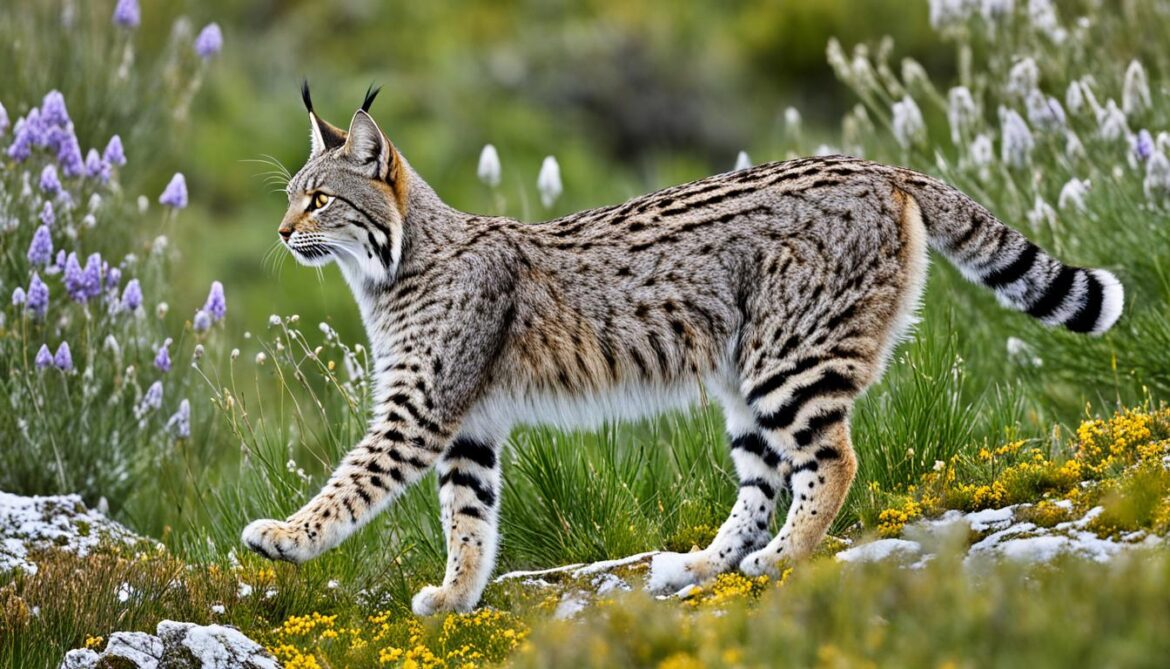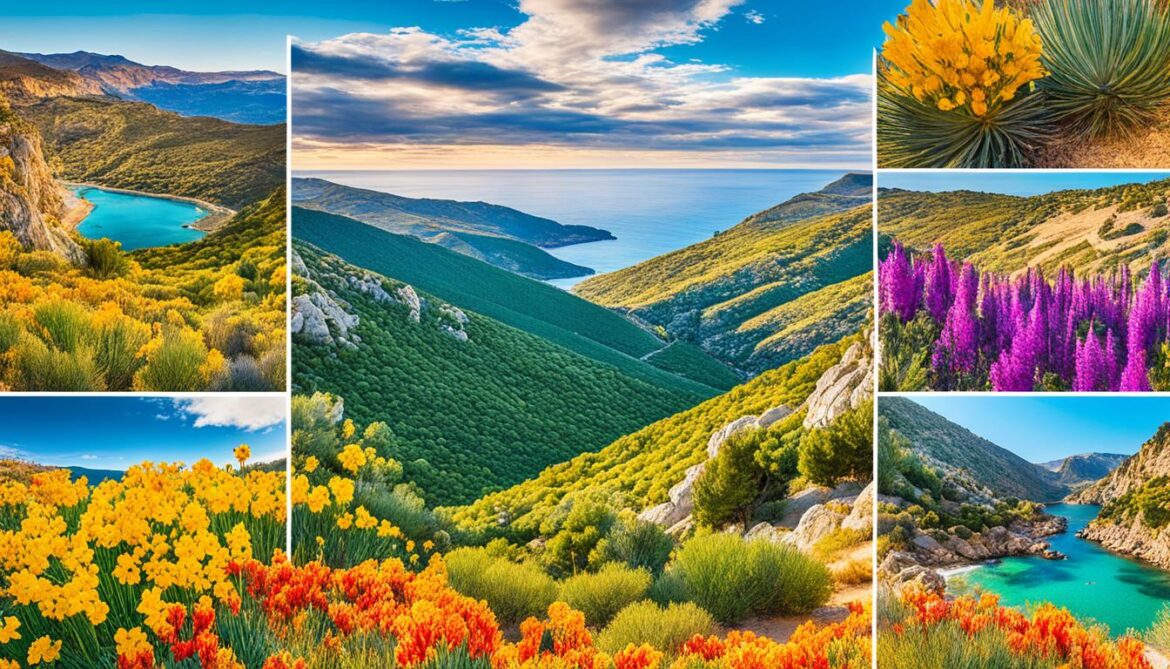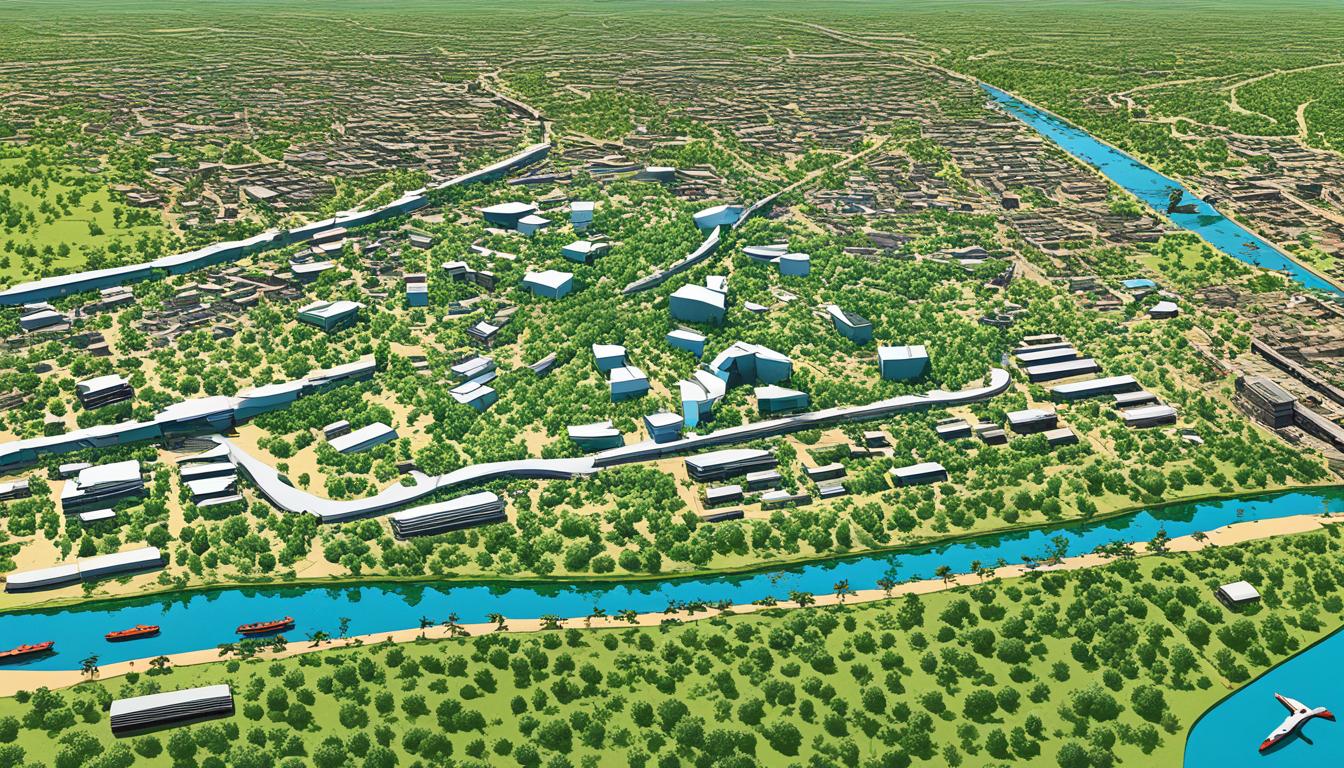Spain Biodiversity and the Built Environment
Spain is renowned for its remarkable biodiversity and the harmonious integration of nature within its built environment. The country’s commitment to environmental conservation, sustainable architecture, and green infrastructure sets an inspiring example for urban planning worldwide. With its diverse wildlife habitats and ecosystem preservation efforts, Spain demonstrates an exceptional dedication to construction sustainability and city biodiversity planning.
Key Takeaways
- Spain is a biodiversity hotspot in Europe, boasting diverse ecosystems and unique endangered species.
- Conservation efforts in Spain prioritize protected areas, conservation plans, and captive breeding programs.
- The implementation of the NBSAP in Spain integrates biodiversity into sectoral policies and encourages public participation.
- Spain has an extensive network of protected areas, including Biosphere Reserves and participation in the Natura 2000 network.
- Habitat loss and climate change pose significant threats to Spain’s biodiversity, making conservation efforts crucial.
Conservation Efforts in Spain
Spain is taking significant steps to ensure the conservation of its diverse and precious biodiversity. The country has established numerous protected areas, including national parks, nature reserves, and biosphere reserves, to safeguard sensitive ecosystems and endangered species. These protected areas provide vital habitats for a wide range of flora and fauna, playing a crucial role in the preservation of Spain’s natural heritage.
One of the key initiatives in Spain’s conservation efforts is its active participation in the Natura 2000 network, which aims to protect Europe’s most valuable habitats and species. This collaboration allows Spain to work alongside other European countries in conserving biodiversity and ensuring the sustainability of ecosystems.
Habitat restoration is also a crucial aspect of conservation in Spain. Efforts are being made to restore and rehabilitate degraded habitats, such as wetlands and forests, to their natural state. By restoring these habitats, Spain can provide suitable environments for endangered species and enhance the overall health of ecosystems.
Spain is committed to protecting its rich biodiversity and has implemented strict regulations against illegal hunting and trading, ensuring the well-being of vulnerable species. Captive breeding programs have been established to breed and reintroduce endangered species back into the wild, contributing to their recovery and population growth.
The conservation plans in Spain are comprehensive and multifaceted, addressing various aspects of biodiversity conservation. These plans encompass research, monitoring, and assessment of species and habitats, as well as the development of strategies for sustainable land management and resource use. By implementing these plans, Spain aims to strike a balance between human activities and the preservation of its natural ecosystems.
| Conservation Efforts | Focus Areas |
|---|---|
| Establishment of Protected Areas | National parks, nature reserves, biosphere reserves |
| Participation in the Natura 2000 network | Protecting valuable habitats and species |
| Habitat Restoration | Restoring degraded habitats to their natural state |
| Regulations against illegal hunting and trading | Ensuring the well-being of vulnerable species |
| Captive Breeding Programs | Breeding and reintroducing endangered species |
| Comprehensive Conservation Plans | Research, monitoring, sustainable land management |
Implementation of the NBSAP in Spain
The implementation of the National Biodiversity Strategy and Action Plan (NBSAP) plays a crucial role in addressing the conservation and sustainable use of biodiversity in Spain. The NBSAP aims to improve knowledge on biodiversity through research and monitoring, integrate biodiversity into sectoral policies such as agriculture and tourism, conserve global biodiversity, and promote public participation in nature conservation.
Spain is committed to protecting its unique biodiversity while promoting sustainable practices for future generations.
“The NBSAP reflects our dedication to preserving Spain’s natural heritage and ensuring a harmonious coexistence of our ecosystems and human activities. Through comprehensive research, monitoring, and the integration of biodiversity conservation into various sectors, we aim to safeguard our country’s rich biodiversity for present and future generations.”
Research and Monitoring
To enhance biodiversity conservation in Spain, the NBSAP focuses on conducting biodiversity research and monitoring efforts. This involves studying various ecosystems, identifying key species, and assessing their population dynamics and habitat requirements. Research findings guide conservation strategies and help policymakers make informed decisions to protect vulnerable species and ecosystems.
Integration into Sectoral Policies
The NBSAP recognizes the importance of integrating biodiversity into sectoral policies, such as agriculture and tourism. By incorporating biodiversity into these sectors, Spain aims to ensure that economic activities occur in a sustainable and environmentally responsible manner. This integration involves promoting sustainable farming practices, protecting wildlife habitats, and implementing guidelines for eco-tourism activities.
Conserving Global Biodiversity
Spain acknowledges its role in conserving not only its own biodiversity but also contributing to the conservation of global biodiversity. The NBSAP outlines strategies to support international initiatives and collaborations that aim to protect endangered species and habitats worldwide. Through participation in international conservation efforts, Spain demonstrates its commitment to preserving biodiversity on a global scale.
Promoting Public Participation
The NBSAP emphasizes the importance of public participation in nature conservation. Spain encourages individuals, communities, and organizations to actively engage in environmental initiatives and projects that promote biodiversity conservation. By fostering public awareness, appreciation, and involvement, Spain aims to create a society that values and actively contributes to the protection and preservation of its biodiversity.
Spain’s implementation of the NBSAP demonstrates the country’s commitment to adopting a holistic approach towards biodiversity conservation. By integrating research, sectoral policies, global cooperation, and public participation, Spain strives to protect its unique natural heritage and promote sustainable practices that ensure the long-term health and vitality of its diverse ecosystems.

Protected Areas and Natura 2000 in Spain
Spain is renowned for its vast and diverse natural landscapes, which are home to a wide array of unique ecosystems and species. To ensure the proper management and protection of these valuable areas, Spain has designated a significant number of protected natural spaces that cover over 30 million hectares of terrestrial space and 12 percent of its marine surface areas.
These protected areas in Spain encompass various types, including national parks, natural parks, and biosphere reserves. National parks such as Doñana National Park and Sierra de Guadarrama National Park showcase the country’s commitment to preserving its exceptional natural heritage. These protected spaces not only safeguard critical habitats but also contribute to the conservation of numerous species that rely on these ecosystems for their survival.
In addition to its national protected areas, Spain actively participates in the Natura 2000 network, an initiative by the European Union to protect Europe’s most valuable habitats and species. As part of this network, Spain has designated numerous Sites of Community Importance (SCIs) and Special Protection Areas (SPAs) to safeguard its biodiversity hotspots and ensure their long-term preservation.
By being part of the Natura 2000 network, Spain demonstrates its commitment to conserving its natural heritage and promoting the sustainable use of its ecosystems. The network serves as a platform for collaboration and knowledge sharing among member states, leading to enhanced conservation efforts and the implementation of effective management practices.

Conservation plans play a crucial role in guiding the sustainable management practices of these protected areas in Spain. These plans outline strategies and initiatives aimed at protecting and preserving the unique ecological features and habitats within these regions. By adhering to these plans, Spain ensures the long-term viability of its protected areas and contributes to the broader global efforts of biodiversity conservation.
The concerted efforts of Spain in designating protected natural spaces and actively participating in the Natura 2000 network are vital for the maintenance and preservation of the country’s rich biodiversity. These initiatives not only protect unique ecosystems and endangered species but also provide opportunities for research, education, and sustainable nature-based tourism.
Endangered Species and Threats in Spain
Spain is home to a diverse range of plant and animal species, many of which are currently endangered. The country’s rich biodiversity is a vital part of its natural heritage and requires protection and conservation efforts to ensure its long-term survival.
One of the major threats to biodiversity in Spain is habitat loss. Urbanization, agricultural expansion, and deforestation have resulted in the destruction and fragmentation of natural habitats, displacing and threatening native species. The loss of essential habitats deprives many species of their food sources, shelter, and breeding grounds.
Another significant threat to biodiversity in Spain is climate change. Rising temperatures, changing precipitation patterns, and extreme weather events impact Spanish ecosystems and species. Climate change disrupts the delicate balance of ecosystems and affects the availability of resources necessary for the survival and reproduction of many species.
Addressing these threats and implementing effective conservation measures are crucial for the protection of vulnerable species and their habitats. Conservation efforts should focus on preserving and restoring habitats, promoting sustainable land use practices, and raising awareness about the importance of biodiversity among the public and policymakers.
“Protecting endangered species and their habitats is not only essential for their survival but also for the overall health and resilience of our ecosystems. It requires a collaborative effort from governments, conservation organizations, and local communities to ensure a future where both humans and wildlife can thrive.”
The Impact of Human Activities
The growth of urban areas, intensive agriculture, and unsustainable resource extraction have played a significant role in habitat loss and degradation in Spain. Urbanization, driven by population growth and economic development, has led to the conversion of natural habitats into concrete jungles, resulting in the displacement of wildlife and the destruction of their habitats.
Intensive agriculture, including the expansion of monoculture crops and the use of pesticides, has further contributed to the loss of biodiversity in Spain. The conversion of diverse natural landscapes into vast agricultural fields has resulted in the loss of native plants and the disruption of ecosystems that support a wide range of species.
Additionally, unsustainable resource extraction, such as deforestation for timber and mining activities, has had a detrimental impact on Spanish biodiversity. Deforestation not only destroys habitats but also eliminates valuable carbon sinks, exacerbating the effects of climate change and further threatening vulnerable species.
The Urgency of Climate Change
Climate change poses an imminent threat to biodiversity in Spain. Rising temperatures and altered precipitation patterns directly impact ecosystems and species, leading to shifts in distribution, changes in phenology, and disruptions in the ecological interactions between species.
Spanish ecosystems, such as Mediterranean forests, wetlands, and montane regions, are particularly vulnerable to the effects of climate change. The loss of suitable habitat, reduced water availability, and increased frequency of extreme weather events threaten the survival of many native species, including endemic and specialized ones.
Conservation efforts need to focus on not only mitigating climate change through reducing greenhouse gas emissions but also adapting to its impacts. This includes promoting the restoration and conservation of resilient ecosystems, strengthening the resilience of endangered species, and implementing strategies for sustainable land and water management.
Conservation Initiatives and Partnerships
To address the threats facing endangered species in Spain, various conservation initiatives and partnerships have been established. These efforts aim to protect and restore habitats, monitor and conserve endangered species, and raise awareness about the importance of biodiversity conservation.
Government agencies, non-profit organizations, and research institutions collaborate to implement conservation programs, develop recovery plans for endangered species, and conduct scientific research to better understand the impacts of habitat loss and climate change.
The involvement of local communities, landowners, and stakeholders is crucial for the success of conservation initiatives. Engaging the public in environmental education and citizen science projects helps to foster a sense of stewardship and promotes sustainable practices that benefit both wildlife and people.

Spain’s Plant and Animal Life
Spain is renowned for its astonishing biodiversity, boasting a wealth of wildlife and vegetation. With approximately 70,000 animal species and over 10,000 plant species, the country is a haven for nature enthusiasts and conservationists alike.
One of the key factors contributing to Spain’s remarkable wildlife is its strategic location. Situated at the crossroads of Europe and Africa, Spain serves as a vital migratory route for numerous bird species, making it an ideal destination for birdwatching enthusiasts.
When it comes to mammals, Spain is home to iconic creatures such as the wolf, brown bear, and Iberian lynx, all of which captivate wildlife lovers with their majestic presence. The Iberian lynx, in particular, is an endemic species in Spain, making its conservation a top priority for wildlife preservation efforts.
The Canary Islands, off the coast of northwest Africa, deserve special mention for their high number of endemic species. These unique creatures, found nowhere else in the world, have adapted to the islands’ distinctive ecosystems, making the archipelago a true treasure trove of biodiversity.
In addition to its remarkable animal life, Spain’s vegetation is equally diverse. The country is blessed with a range of habitats, from extensive forests and mesmerizing valleys in the north to vast plains, steppes, and lush Mediterranean forests in the inland and coastal regions.
To provide a visual representation of Spain’s rich biodiversity, below is a table highlighting some of the country’s prominent wildlife species:
| Animal Species | Habitat | Status |
|---|---|---|
| Wolf | Forests and mountains | Endangered |
| Brown Bear | Pyrénées and Cantabrian Mountains | Vulnerable |
| Iberian Lynx | Mediterranean scrubland | Critically Endangered |
| Spanish Imperial Eagle | Countryside and wetland areas | Endangered |
| Iberian Ibex | Mountainous regions | Near Threatened |
It is evident that Spain’s plant and animal life are not only ecologically significant but also contribute to the cultural and natural heritage of the country. As Spain continues to prioritize conservation efforts, the preservation of its diverse ecosystems and endemic species remains a crucial component of its commitment to protect and sustain its remarkable biodiversity.

Environmental Policy and Sustainable Development in Spain
Spain is committed to environmental protection and sustainable development, reflecting its growing awareness of the importance of preserving the natural world. The country has implemented the Strategic Sustainable Development Strategy, which lays the foundation for integrating sustainable practices into all sectors of society. Spain actively participates in international environmental protection programs and agreements, working collaboratively to address global challenges.
One of Spain’s key initiatives is its dedication to the Sustainable Development Goals (SDGs) outlined in the 2030 Agenda for Sustainable Development. These goals encompass a wide range of environmental, social, and economic objectives aimed at creating a more sustainable and equitable future for all. Spain’s focus areas include the conservation of ecosystems, reduction of pollution, and mitigation of climate change. By aligning its efforts with the SDGs, Spain aims to contribute to the global sustainable development agenda.
“Sustainability is not just a buzzword for Spain; it is a core value that guides our policies and actions. We understand that protecting the environment and promoting sustainable development go hand in hand, and we are committed to ensuring a resilient and thriving future for our country.”
International Environmental Agreements
Spain actively participates in various international environmental agreements to collaborate on addressing global environmental challenges. These agreements provide platforms for countries to exchange knowledge, best practices, and resources to implement effective environmental policies. Spain’s involvement in these agreements reflects its commitment to global environmental stewardship and underscores its role as a responsible member of the international community.
- The United Nations Framework Convention on Climate Change (UNFCCC): Spain is a signatory to the UNFCCC and actively supports efforts to mitigate climate change and adapt to its effects. The country is dedicated to reducing greenhouse gas emissions and transitioning to a low-carbon economy.
- The Paris Agreement: Spain has ratified the Paris Agreement, demonstrating its commitment to limit global warming well below 2 degrees Celsius and pursue efforts to keep it below 1.5 degrees Celsius. Spain seeks to contribute to global climate action and promote sustainable development in line with the agreement’s objectives.
- The Convention on Biological Diversity (CBD): Spain is a party to the CBD and works towards the conservation and sustainable use of biodiversity. The country’s efforts include the establishment of protected areas, conservation programs, and initiatives to enhance public awareness and participation in biodiversity conservation.
Strategies for Climate Change Mitigation
Spain recognizes the urgency of addressing climate change and has implemented strategies to mitigate its impacts. These strategies focus on reducing greenhouse gas emissions, increasing energy efficiency, and transitioning to renewable energy sources.
In recent years, Spain has made significant progress in renewable energy development, particularly in solar and wind power. The country aims to achieve 74% of its electricity generation from renewable sources by 2030. By investing in clean energy infrastructure, Spain is not only reducing its carbon footprint but also creating job opportunities and driving economic growth.

Environmental Protection and Sustainable Policies
Spain has implemented stringent environmental protection policies to safeguard its natural resources and mitigate environmental degradation. These policies encompass various sectors, including agriculture, industry, transportation, and waste management.
Through sustainable farming practices, Spain aims to reduce the environmental impact of agriculture while ensuring food security and promoting rural development. The country also encourages sustainable transportation options, such as public transport systems and cycling infrastructure, to reduce air pollution and promote active lifestyles.
Spain’s waste management policies prioritize recycling and waste reduction, aiming to minimize the amount of waste sent to landfills. The country has implemented a circular economy approach, which focuses on resource efficiency and sustainable consumption and production patterns.
| Environmental Protection Initiatives in Spain | Sustainable Development Goals |
|---|---|
| Renewable energy promotion | Clean and Affordable Energy |
| Protected areas establishment | Life on Land |
| Environmental education programs | Quality Education |
| Promotion of sustainable tourism | Sustainable Cities and Communities |
Spain’s commitment to environmental protection and sustainable development is evident through its policies, participation in international agreements, and dedication to the Sustainable Development Goals. By prioritizing the conservation of ecosystems, climate change mitigation, and sustainable practices across sectors, Spain strives to create a greener and more sustainable future for its citizens and the planet.
Spain’s UNESCO Biosphere Reserves
Spain is proud to have the second-highest number of UNESCO-designated Biosphere Reserves in the world.
The country has 53 Biosphere Reserves, 15 geoparks, and four national parks listed as World Heritage sites.
Spain is also known for its Starlight Reserves, with 15 spaces certified for their quality of night skies for stargazing.
These designations highlight the unique and valuable nature in Spain that requires protection and preservation.

UNESCO Biosphere Reserves in Spain
| Biosphere Reserves | Geoparks | World Heritage Sites | Starlight Reserves |
|---|---|---|---|
| 1. Sierra de las Nieves | 1. Sobrarbe-Pirineos | 1. Doñana National Park | 1. Starlight Reserve Montsec |
| 2. La Palma | 2. Catalunya Central | 2. Teide National Park | 2. Starlight Reserve La Palma |
| 3. Menorca | 3. Cabo de Gata-Níjar | 3. Garajonay National Park | 3. Starlight Reserve La Palma |
| 4. Güímar Pyramids | 4. Villuercas-Ibores-Jara | 4. Lanzarote | 4. Starlight Reserve Montsec |
Spain’s Natural Wonders
Spain is blessed with a diverse range of natural wonders. From the volcanic formations of Teide and Timanfaya to the rugged slopes of Caldera de Taburiente and the fabulous Garajonay laurel forest, there is something for every nature enthusiast. Spain’s natural wonders include dense forests, waterfalls, marshlands, wetlands, plains, rock fields, glacial cirques, and paradise-like beaches. The country offers a multitude of landscapes and monuments that showcase its extraordinary biodiversity.
Among Spain’s most iconic natural wonders are its volcanic formations. The volcanic island of Tenerife is home to Mount Teide, the highest peak in Spain and a UNESCO World Heritage site. With its otherworldly landscapes, Teide National Park is a paradise for hikers and photographers alike. The volcanic region of Timanfaya in Lanzarote is another awe-inspiring natural wonder, with its unique red and black lava fields.
Spain’s natural parks are also a testament to the country’s diverse and stunning landscapes. Spanning across the country, these protected areas are home to a wide range of wildlife and offer countless opportunities for outdoor activities such as hiking, birdwatching, and wildlife spotting. From the stunning Picos de Europa in Northern Spain to the mystical Doñana National Park in the south, Spain’s natural parks are a haven for nature lovers.
| Volcanic Formations | Natural Parks | Coastal Cliffs |
|---|---|---|
| Teide National Park – Tenerife | Picos de Europa – Northern Spain | Cliffs of Moher – Ireland |
| Timanfaya National Park – Lanzarote | Doñana National Park – Southern Spain | Seven Sisters – England |
| Caldera de Taburiente – La Palma | Sierra de Grazalema – Andalusia | Etretat Cliffs – France |
Coastal cliffs are another remarkable natural wonder in Spain. The rugged cliffs along the Atlantic coast provide breathtaking views of the crashing waves and dramatic landscapes. From the Cliffs of Moher in Ireland to the Seven Sisters in England, Europe is home to some of the most stunning coastal cliffs. While not exclusive to Spain, these natural formations add to the country’s overall charm and allure.
With its abundance of natural wonders, Spain is a paradise for outdoor enthusiasts and nature lovers. Whether you are mesmerized by volcanic landscapes, enchanted by lush forests, or captivated by coastal cliffs, Spain offers a wealth of opportunities to explore and appreciate its extraordinary natural beauty.

Spain’s Protected Areas and Sustainable Tourism
Spain is a country that places great emphasis on sustainable tourism and the preservation of its natural environment. As part of its commitment to conservation, the country has integrated sustainable practices into the management of its protected areas. These protected areas, including national parks, nature reserves, and biosphere reserves, are crucial for safeguarding Spain’s rich biodiversity while allowing visitors to enjoy its natural wonders responsibly.
A notable achievement is that thirty natural spaces in Spain have received the prestigious European Charter for Sustainable Tourism certification. This certification signifies that these areas adhere to responsible tourism practices, such as promoting local economies, protecting wildlife habitats, and involving local communities in decision-making processes. By adopting sustainable tourism principles, Spain ensures that visitors can experience the country’s natural beauty while minimizing negative impacts on the environment and local communities.
Several destinations in Spain have also been recognized and included in the European Destinations of Excellence (EDEN) Network. The EDEN Network aims to promote sustainable tourism by highlighting lesser-known destinations that offer unique cultural and natural heritage. These destinations in Spain provide visitors with authentic and sustainable experiences, encouraging them to explore off-the-beaten-track locations and support local economies.
Another testament to Spain’s dedication to sustainable coastal tourism is the abundance of Blue Flag beaches. Spain boasts numerous Blue Flag beaches, indicating their commitment to maintaining high environmental standards, such as water quality, environmental management, and safety. These beaches serve as shining examples of Spain’s responsible approach to coastal conservation, providing visitors with pristine environments to enjoy while fostering environmentally friendly practices.
“Sustainable tourism is not just about preserving the environment, but also about maintaining cultural authenticity and generating economic benefits for local communities.” – Andrés Gómez de Lara, Director of the Spanish Tourism Office
European Charter for Sustainable Tourism Certification
The European Charter for Sustainable Tourism (ECST) is an initiative that recognizes destinations committed to sustainable tourism practices. It promotes the protection of natural and cultural heritage while ensuring the well-being of local communities. The ECST certification process involves a comprehensive evaluation of the destination’s sustainability initiatives, including environmental management, socio-cultural impacts, and economic viability.
| Protected Area | Location | Year of Certification |
|---|---|---|
| Doñana National Park | Andalusia | 1997 |
| Cabo de Gata-Níjar Natural Park | Andalusia | 1999 |
| Ordesa and Monte Perdido National Park | Aragon | 2017 |
| Cazorla, Segura and Las Villas Natural Park | Andalusia | 2017 |
These are just a few examples of the protected areas in Spain that have received the European Charter for Sustainable Tourism certification. Each certified area contributes to the overall sustainable tourism efforts in the country, providing visitors with unforgettable experiences while preserving the unique ecosystems and cultural heritage of Spain.
Spain’s Blue Flag Beaches
Spain takes pride in its Blue Flag beaches, symbolizing their commitment to preserving coastal ecosystems and providing high-quality beach experiences. The Blue Flag program, run by the Foundation for Environmental Education (FEE), awards beaches and marinas that meet stringent environmental, safety, and accessibility criteria.
| Region | Number of Blue Flag Beaches |
|---|---|
| Catalonia | 99 |
| Valencia | 100 |
| Andalusia | 88 |
| Balearic Islands | 66 |
The abundance of Blue Flag beaches in Spain demonstrates the country’s commitment to coastal conservation and providing visitors with pristine seaside experiences. These beaches offer transparent water, clean sands, and excellent facilities, ensuring that tourists can enjoy Spain’s coastlines sustainably while protecting these fragile ecosystems for future generations.
Spain’s dedication to sustainable tourism, as evidenced by its European Charter for Sustainable Tourism certifications and abundance of Blue Flag beaches, showcases the country’s responsible approach to conservation. By promoting sustainable practices in its protected areas and coastal destinations, Spain ensures that both nature and tourism can thrive harmoniously.
Spain’s Environmental Awareness and Conservation Efforts
Spain recognizes the importance of environmental education and public engagement in conservation efforts. The country actively encourages public participation in decision-making processes and promotes environmental education to foster a sense of responsibility towards biodiversity and ecosystem protection. Through various initiatives, Spain aims to generate awareness and empower citizens to actively contribute to nature conservation.
One of the key areas of focus is environmental education. Spain emphasizes the need to educate individuals about the importance of conserving the environment and the role they can play in protecting it. By integrating environmental education into school curricula and organizing awareness campaigns, Spain aims to instill a sense of stewardship and sustainability in future generations.
“Environmental education is crucial in fostering a deeper understanding of the interconnectedness between humans and the natural world. By equipping individuals with the knowledge and tools to make informed decisions, we can create a society that actively participates in environmental conservation.” – Maria Rodriguez, Environmental Educator
Furthermore, Spain believes that public engagement is essential for effective conservation. The country actively involves communities, organizations, and individuals in decision-making processes related to environmental policies and conservation initiatives. By providing opportunities for public input, Spain ensures that a diverse range of perspectives are considered, leading to more comprehensive and inclusive conservation strategies.
Spain also recognizes the importance of collaborating with non-governmental organizations (NGOs) and other stakeholders to implement environmental conservation initiatives. Through partnerships with local and international organizations, Spain combines resources, expertise, and knowledge to address environmental challenges and protect biodiversity. Such collaborative efforts have led to the creation of innovative projects focused on habitat restoration, species conservation, and sustainable development.
Environmental Education Initiatives in Spain
Spain has implemented various environmental education initiatives to raise awareness and promote sustainable practices. Here are some notable examples:
- Green Schools Program: Spain’s Green Schools Program encourages schools to incorporate environmental education into their curriculum and implement sustainable practices within their premises. This initiative aims to instill environmental values in students and empower them to become environmental stewards.
- Nature Interpretation Centers: Spain has established Nature Interpretation Centers across the country, offering interactive exhibits, guided nature walks, and educational workshops. These centers provide valuable learning opportunities for individuals of all ages, fostering a deeper connection with nature.
- Environmental Youth Organizations: Spain promotes the formation of environmental youth organizations to empower young people to take action and drive positive change in their communities. These organizations provide platforms for young individuals to collaborate, share ideas, and implement environmental projects.
Public Engagement and Participation
Spain actively engages the public in decision-making processes related to environmental conservation. The country organizes public consultations, workshops, and public awareness campaigns to ensure that the voices and opinions of citizens are heard and considered. By involving communities and individuals in environmental discussions, Spain aims to create a sense of ownership and shared responsibility for biodiversity conservation.
“Public engagement is crucial in fostering a sense of collective responsibility for our environment. By involving communities and individuals in decision-making processes, we can develop more comprehensive and sustainable solutions that address the diverse needs and concerns of our society.” – Ana Castillo, Environmental Activist
Achievements and Future Outlook
Spain’s efforts in promoting environmental education and public engagement have yielded significant achievements. The country has witnessed an increase in public awareness and participation in conservation initiatives. Furthermore, the integration of environmental education into school curricula has resulted in a generation of environmentally conscious individuals who actively contribute to biodiversity conservation.
Looking ahead, Spain continues to prioritize environmental education and public engagement as essential pillars of its conservation efforts. The country aims to expand its educational programs, strengthen partnerships with NGOs and stakeholders, and harness the power of public participation to drive sustainable change. By fostering environmental awareness and empowering citizens, Spain is paving the way for a more sustainable and resilient future.
Conclusion
In conclusion, the conservation efforts in Spain have played a vital role in protecting the country’s rich biodiversity and ensuring the future sustainability of its ecosystems. By establishing protected areas, implementing conservation plans, and integrating into international networks, Spain has showcased its commitment to preserving its natural heritage.
These efforts are crucial in safeguarding the delicate balance between the built environment and biodiversity, as Spain recognizes the dependence they have on each other. Through continued commitment to conservation and the adoption of sustainable practices, Spain can create a future where both nature and society can flourish.
It is imperative that Spain’s conservation efforts continue in order to address the threats to biodiversity, promote environmental education, and engage the public in the protection of the natural environment. By doing so, Spain can set an example for the rest of the world and contribute significantly to global conservation initiatives.








